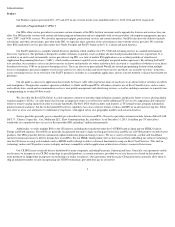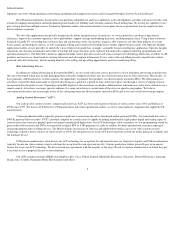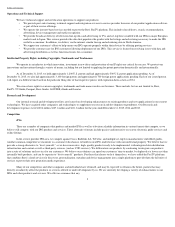TiVo 2015 Annual Report Download - page 17
Download and view the complete annual report
Please find page 17 of the 2015 TiVo annual report below. You can navigate through the pages in the report by either clicking on the pages listed below, or by using the keyword search tool below to find specific information within the annual report.
Table of Contents
We derive significant revenues from CE manufacturer license fees for our solutions that are based on the number of units shipped. We do not
manufacture hardware, but rather depend on the cooperation of CE manufacturers to incorporate our technologies into their products. Generally, our license
agreements do not require manufacturers to include our technology in any specific number or percentage of units, and only some of these agreements
guarantee a minimum aggregate license fee. Purchases of new CE devices, including television sets, integrated satellite receiver decoders, DVRs, DVD
recorders, personal computers and internet appliances are largely discretionary and may be adversely impacted by increasing market saturation, durability
of products in the marketplace, new competing products, alternate consumer entertainment options and general economic trends in the countries or regions
in which these products are offered. Economic downturns have in the past, and may in the future, significantly impact demand for such CE devices. As a
result, our future operating results may be adversely impacted by fluctuations in sales of CE devices employing our technologies.
The decision by manufacturers to incorporate our solutions into their products is a function of what other technologies, products and services are
available. Our future operating results may be adversely impacted as a result of CE manufacturers opting not to incorporate our technology into their
devices as a result of other available alternatives.
We are exposed to risks associated with our changing technology base through strategic acquisitions, investments and divestitures.
We have expanded our technology base in the past through strategic acquisitions of companies with complementary technologies or IP and
intend to do so in the future. Acquisitions hold special challenges in terms of successful integration of technologies, products, services and employees.
We may not realize the anticipated benefits of these acquisitions or the benefits of any other acquisitions we have completed or may complete in the future,
and we may not be able to incorporate any acquired services, products or technologies with our existing operations, or integrate personnel from the
acquired businesses, in which case our business could be harmed.
Acquisitions, divestitures and other strategic investments involve numerous risks, including:
Financing for future acquisitions may not be available on favorable terms, or at all. If we identify an appropriate acquisition candidate for any of
our businesses, we may not be able to negotiate the terms of the acquisition successfully, finance the acquisition or integrate the acquired business,
products, service offerings, technologies or employees into our existing business and operations. Future acquisitions and divestitures may not be well
-
received by the investment community, which may cause the value of our stock to fall. We cannot ensure that we will be able to identify or complete any
acquisition or divestiture in the future. Further, the terms of our indebtedness constrains our ability to make and finance additional acquisitions or
divestitures.
If we acquire businesses, new products, service offerings or technologies in the future, we may incur significant acquisition
-
related costs. In
addition, we may be required to amortize significant amounts of finite
-
lived intangible assets and we may record significant amounts of goodwill or
indefinite
-
lived intangible assets that would be subject to testing for impairment. We have in the past and may in the future be required to write off all or
part of the intangible assets or goodwill associated with these investments that could harm our operating results. If we consummate one or more significant
future acquisitions in which the consideration consists of stock or other securities, our existing stockholders' ownership could be significantly diluted. If we
were to proceed with one or more significant future acquisitions in which the consideration included cash, we could be required to use a substantial portion
of our cash and investments. Acquisitions could also cause operating margins to fall depending on the businesses acquired.
15
•
problems integrating and divesting the operations, technologies, personnel, services or products over geographically disparate locations;
•
unanticipated costs, taxes, litigation and other contingent liabilities;
•
continued liability for pre
-
closing activities of divested businesses or certain post
-
closing liabilities which we may agree to assume as part
of the transaction in which a particular business is divested;
•
adverse effects on existing business relationships with suppliers and customers;
•
cannibalization of revenue as customers may seek multi
-
product discounts;
•
risks associated with entering into markets in which we have no, or limited, prior experience;
•
incurrence of significant restructuring charges if acquired products or technologies are unsuccessful;
•
significant diversion of management's attention from our core business and diversion of key employees' time and resources;
•
licensing, indemnity or other conflicts between existing businesses and acquired businesses;
•
inability to retain key customers, distributors, suppliers, vendors and other business relations of the acquired business; and
•
potential loss of our key employees or the key employees of an acquired organization.
























